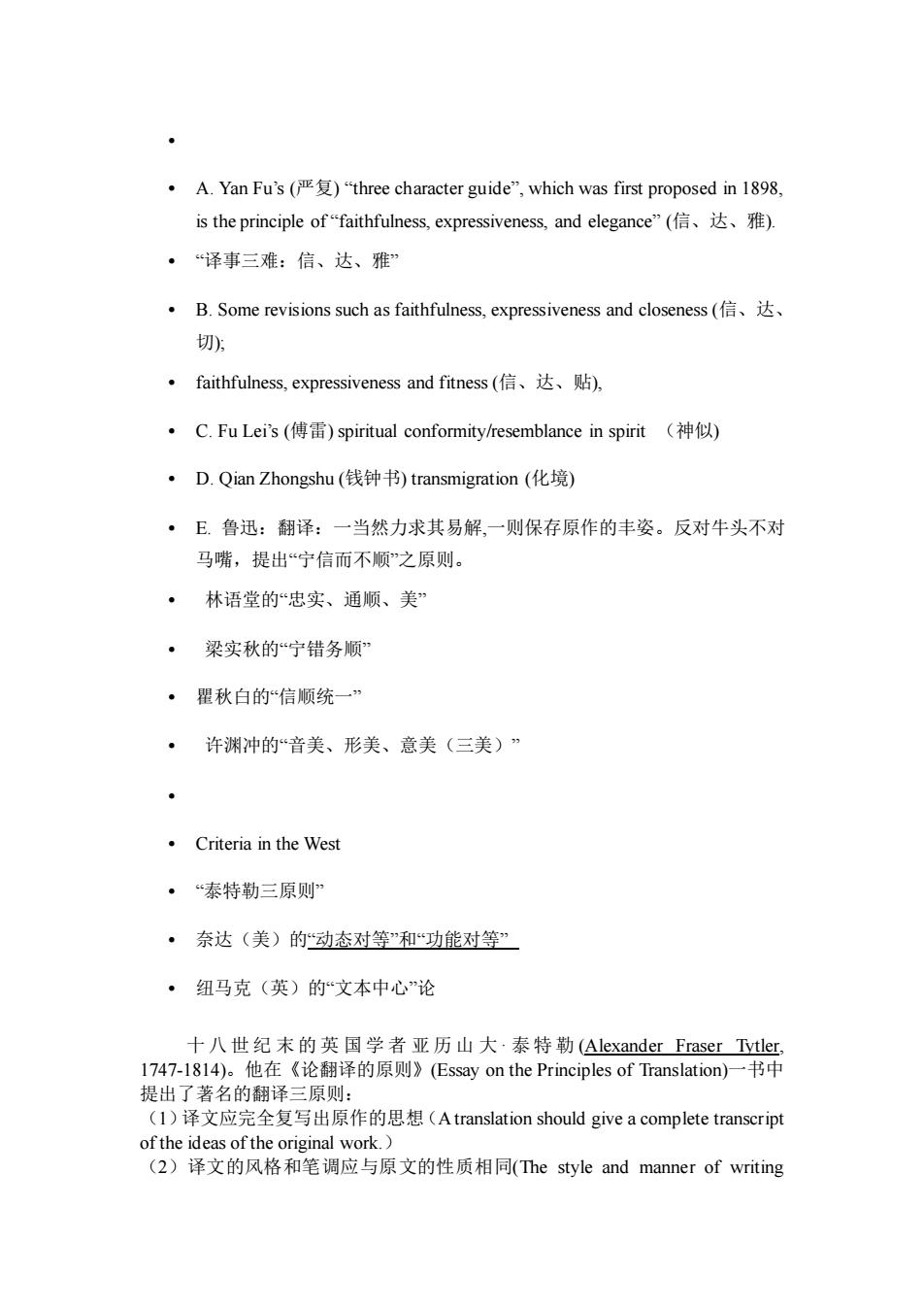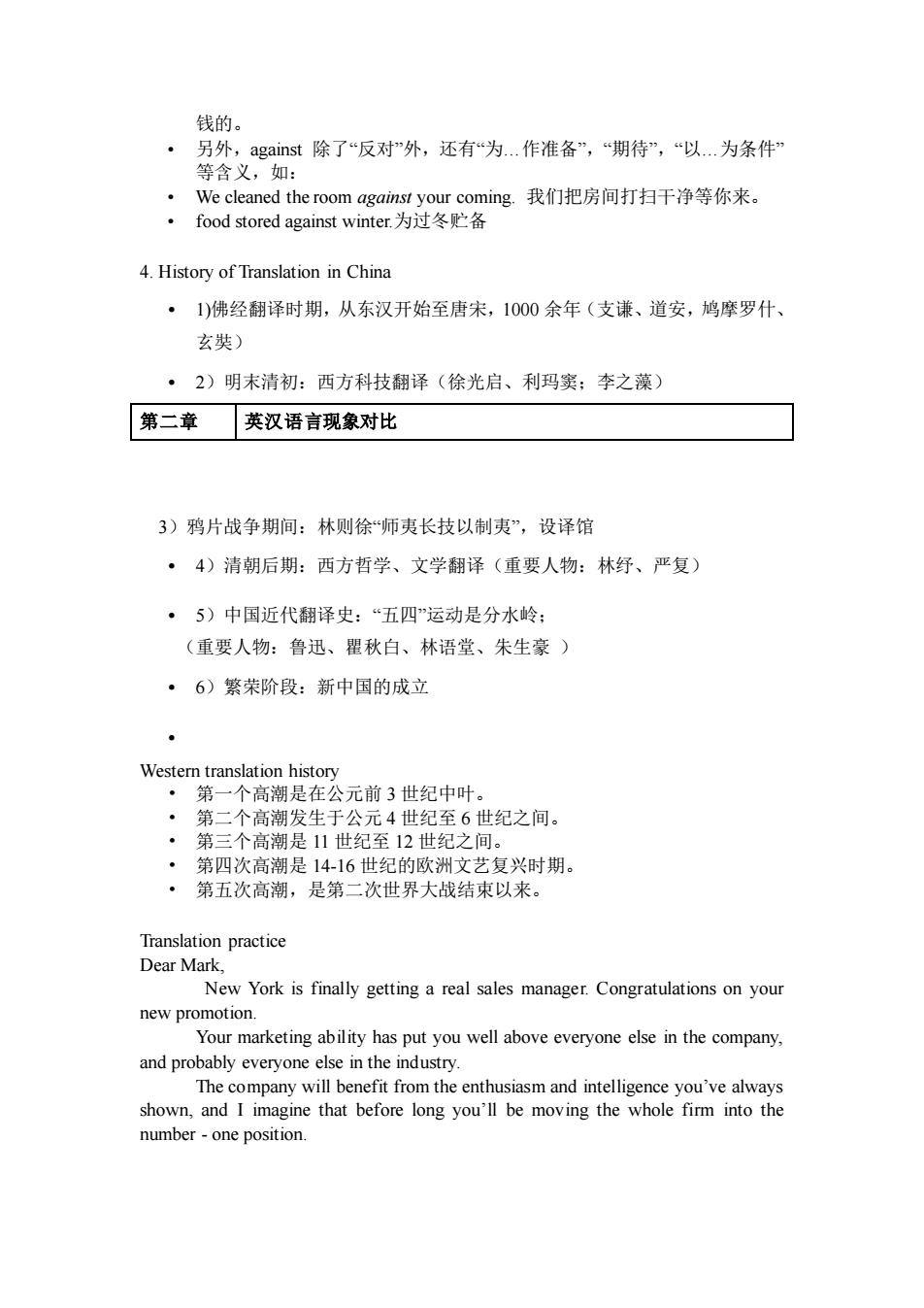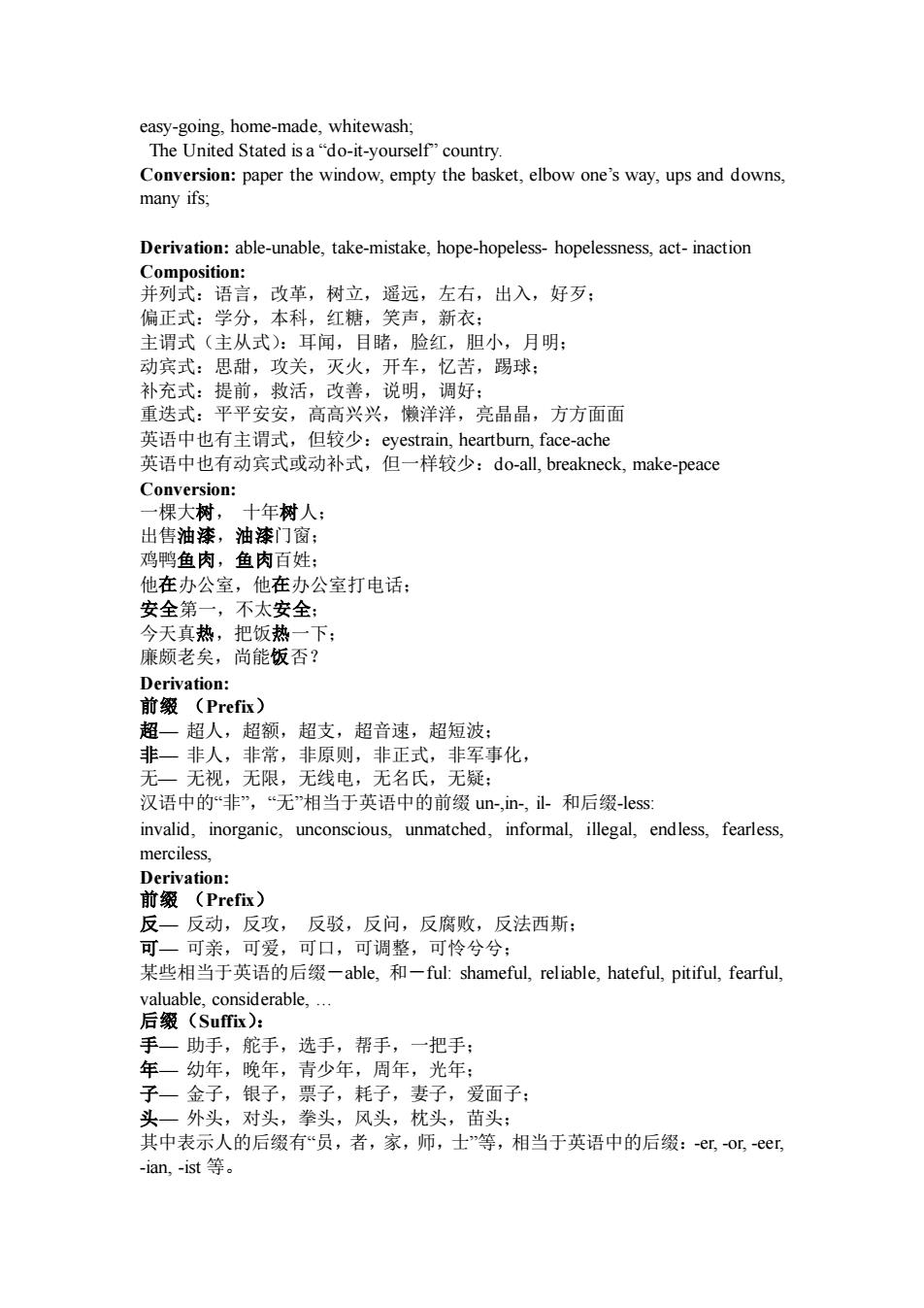
·A.Yan Fu's(严复)"three character guide'”,which was first proposed in 1898, is the principle of“faithfulness,expressiveness,and elegance”(信、达、雅). ·“译事三难:信、达、雅 ·B.Some revisions such as faithfulness,expressiveness and closeness(信、达、 切奶 ·faithfulness,expressiveness and fitness(信、达、贴), ·C.Fu Lei's(傅雷)spiritual conformity/resemblance in spirit(t神似以) ·D.Qian Zhongshu(钱钟书)transmigration(化境) ·E.鲁迅:翻译:一当然力求其易解,一则保存原作的丰姿。反对牛头不对 马嘴,提出“宁信而不顺之原则。 林语堂的“忠实、通顺、美” 梁实秋的“宁错务顺 ·盟秋白的信顺统一” ·许渊冲的“音美、形美、意美(三美)” ·Criteria in the West ·“泰特勒三原则 ·奈达(美)的“动态对等”和“功能对等” ·纽马克(英)的“文本中心”论 十八世纪末的英国学者亚历山大·泰特勒(Alexander Fraser Tytler 1747-1814)。他在《论翻译的原则》(Essay on the Principles of Translation)一书中 提出了著名的翻译 原则 (1)译文应完全复写出原作的思想(Atranslation should give a complete transcript of the ideas of the original work. (2)译文的风格和笔调应与原文的性质相同(The style and manner of writing
• • A. Yan Fu’s (严复) “three character guide”, which was first proposed in 1898, is the principle of “faithfulness, expressiveness, and elegance” (信、达、雅). • “译事三难:信、达、雅” • B. Some revisions such as faithfulness, expressiveness and closeness (信、达、 切); • faithfulness, expressiveness and fitness (信、达、贴), • C. Fu Lei’s (傅雷) spiritual conformity/resemblance in spirit (神似) • D. Qian Zhongshu (钱钟书) transmigration (化境) • E. 鲁迅:翻译:一当然力求其易解,一则保存原作的丰姿。反对牛头不对 马嘴,提出“宁信而不顺”之原则。 • 林语堂的“忠实、通顺、美” • 梁实秋的“宁错务顺” • 瞿秋白的“信顺统一” • 许渊冲的“音美、形美、意美(三美)” • • Criteria in the West • “泰特勒三原则” • 奈达(美)的“动态对等”和“功能对等” • 纽马克(英)的“文本中心”论 十 八 世 纪 末 的 英 国 学 者 亚 历 山 大 ·泰特勒 (Alexander Fraser Tytler, 1747-1814)。他在《论翻译的原则》(Essay on the Principles of Translation)一书中 提出了著名的翻译三原则: (1)译文应完全复写出原作的思想(A translation should give a complete transcript of the ideas of the original work.) (2)译文的风格和笔调应与原文的性质相同(The style and manner of writing

should be of the same character as that of the original (3)译文应和原作同样流畅(A translation should have all the ease of the original composition.) Equivalent effect对等 把翻译中的“意义“概括成“语义和“语体”: Translating consists in r reproducing in the receptor language the natural equivalent of the source-language message,first in terms of meaning and secondly in erms or style (所谓翻译,是指在译语中用最切近而又自然的对等语再现原语的信息,首先在 语义上,其次在文体上。) In conclusio 、以译入语和译出语为取向的翻译原则 the source-language-oriented or the target-language-orented translation principle) ·以译出语为取向 ·Milky way The apple of my eye Every dog has its day. 以译入语为取问 When Greek meets Greek.then comes the tug of war ·Solomon Spring,the sweet spring,is the year's king. 二、以作者和读者为取向的翻译原则 (the author-and-reader-oriented translation principle) 三、以美学为取向的翻译原则 (the aesthetic-oriented translation principle) The Process of Translation A.Preparation:basic knowledge about both languages as well as the background knowledge:basic skills in translation are necessary 。 B.Con prehension understanding accurately the meaning of the source language:How? C.Expression/Representation:try to express the meaning in idiomatic Chinese; d.Revision/proofreading:check again and again to polish the language The new secretary was rude to the workers,but when she talks to the boss butter wouldn't melt in her mouth 道貌岸然,看起来十分清白、天真,实际上 The goods were handed over for disposal against payment by the customer ·Against:在此作为“以.为条件”解。因而应译作:商品卖给顾客,是要付
should be of the same character as that of the original.) (3)译文应和原作同样流畅(A translation should have all the ease of the original composition.) Equivalent effect 对等 把翻译中的“意义”概括成“语义”和“语体”: Translating consists in reproducing in the receptor language the closest natural equivalent of the source-language message, first in terms of meaning and secondly in terms of style. (所谓翻译,是指在译语中用最切近而又自然的对等语再现原语的信息,首先在 语义上,其次在文体上。) In conclusion 一、以译入语和译出语为取向的翻译原则 • (the source-language-oriented or the target-language-oriented translation principle) • 以译出语为取向 • Milky way • The apple of my eye • Every dog has its day. • 以译入语为取向 • When Greek meets Greek, then comes the tug of war. • Solomon • Spring, the sweet spring, is the year’s king. 二、以作者和读者为取向的翻译原则 (the author-and-reader-oriented translation principle) 三、以美学为取向的翻译原则 (the aesthetic-oriented translation principle) The Process of Translation • A. Preparation: basic knowledge about both languages as well as the background knowledge; basic skills in translation are necessary; • B. Comprehension: understanding accurately the meaning of the source language; How? • C. Expression/Representation: try to express the meaning in idiomatic Chinese; • D. Revision /proofreading: check again and again to polish the language. • The new secretary was rude to the workers,but when she talks to the boss, butter wouldn’t melt in her mouth. 道貌岸然,看起来十分清白、天真,实际上. • The goods were handed over for disposal against payment by the customer. • Against: 在此作为“以.为条件”解。因而应译作:商品卖给顾客,是要付

钱的。 另外 against除了反对外,还有为.作准备,期待,“以为条件 等含义,如 We cleaned the room against your coming.我们把房间打扫干净等你来。 ·food stored against winter.为过冬贮备 4.History of Translation in China ·1)佛经翻译时期,从东汉开始至唐宋,1000余年(支谦、道安,鸠摩罗什、 玄奘) ·2)明末清初:西方科技翻译(徐光启、利玛窦:李之藻) 第二章英汉语言现象对比 3)鸦片战争期间:林则徐“师夷长技以制夷”,设译馆 ·4)清朝后期:西方哲学、文学翻译(重要人物:林纾、严复) ·5)中国近代翻译史:“五四”运动是分水岭: (重要人物:鲁迅、瞿秋白、林语堂、朱生豪) ·6)繁荣阶段:新中国的成立 ~高潮是在公元前3世纪中叶。 第二个高潮发生于公元4世纪至6世纪之间。 ·第三个高潮是11世纪至12世纪之间。 ·第四次高潮是14-16世纪的欧洲文艺复兴时期。 ·第五次高海,是第二次世界大战结束以来。 Translation practice Dear Mark, New York is finally getting a real sales manager.Congratulations on your new promotion. Your marketing ability has put you well above everyone else in the company, and probably everyone else in the industry. The company will benefit from the enthusiasm and intelligence you've always shown,and I imagine that before long you'll be moving the whole firm into the number-one position
钱的。 • 另外,against 除了“反对”外,还有“为.作准备”,“期待”,“以.为条件” 等含义,如: • We cleaned the room against your coming. 我们把房间打扫干净等你来。 • food stored against winter.为过冬贮备 4. History of Translation in China • 1)佛经翻译时期,从东汉开始至唐宋,1000 余年(支谦、道安,鸠摩罗什、 玄奘) • 2)明末清初:西方科技翻译(徐光启、利玛窦;李之藻) 3)鸦片战争期间:林则徐“师夷长技以制夷”,设译馆 • 4)清朝后期:西方哲学、文学翻译(重要人物:林纾、严复) • 5)中国近代翻译史:“五四”运动是分水岭; (重要人物:鲁迅、瞿秋白、林语堂、朱生豪 ) • 6)繁荣阶段:新中国的成立 • Western translation history • 第一个高潮是在公元前 3 世纪中叶。 • 第二个高潮发生于公元 4 世纪至 6 世纪之间。 • 第三个高潮是 11 世纪至 12 世纪之间。 • 第四次高潮是 14-16 世纪的欧洲文艺复兴时期。 • 第五次高潮,是第二次世界大战结束以来。 Translation practice Dear Mark, New York is finally getting a real sales manager. Congratulations on your new promotion. Your marketing ability has put you well above everyone else in the company, and probably everyone else in the industry. The company will benefit from the enthusiasm and intelligence you’ve always shown, and I imagine that before long you’ll be moving the whole firm into the number - one position. 第二章 英汉语言现象对比

教学目的 to learn about the similarities and differences of Chinese and English in w ord forming and vocabulary so as to translat them accurately 教学内容 1.Comparative studies of language family 2.Cor arative studies of word building in English and Chines 3. Comparative studies of syllable Exercise 难点 The differences between the Chinese and English language Procedures Procedures Step I Brief review of the last lecture StepII Presentation 1.The language features of the Chinese language 2.The language features of English 3.The differences between the Chinese language and English Step IlI Answer students'questions Step IV Homework L.Language Families(语系) branch of the Indo-European It is well known that English has the richest vocabulary of any European language. On the basis of Angles'language (Anglo-Saxon),English was built by absorbing words in various languages: E. Latin:Pen,pencil,cup,butter,silk French:pork.feast.sir.noble. Italian:piano,solo,studio,opera,umbrella,pilgrim, Chinese:tea,c ow mein,kowtow,toufu, Originally English had its gender,case,number,conjugation-these complicated changes.Because of the wide borrowings,English couldn't keep the changes,case disappearing,gender being not so strict as some other languages,only remaining and only nouns having the changes words can only be formed by means of derivation,composition and conversion,etc. II.Word-building The major ways of word-building in English are composition.conversion. Composition:motherland,blackboard,waterworks,handwriting.silkworm,outbreak
I. Language Families (语系) English belongs to the Germanic branch of the Indo-European language family(印欧语系). Chinese belongs to the Sino-Tibetan language family(汉藏语系). It is well known that English has the richest vocabulary of any European language. On the basis of Angles’ language (Anglo-Saxon), English was built by absorbing words in various languages: E.g. Latin: Pen, pencil, cup, butter, silk French: pork, feast, sir, noble, Italian: piano, solo, studio, opera, umbrella, pilgrim, Spanish: cargo, cigarette, cigar, Greek: paper, alphabet, dialogue, comedy Chinese: tea, chow mein, kowtow, toufu, Originally English had its gender, case, number, conjugation—these complicated changes. Because of the wide borrowings, English couldn’t keep the changes, case disappearing, gender being not so strict as some other languages, only subjective case and objective case remaining and only pronouns having the changes. As English absorbed foreign words only, without absorbing grammar rules, new words can only be formed by means of derivation, composition and conversion, etc. II. Word-building The major ways of word-building in English are composition, conversion, and derivation (affixation). And in Chinese we have the same major ways. English: Composition: motherland, blackboard, waterworks, handwriting, silkworm, outbreak, 教学目的 to learn about the similarities and differences of Chinese and English in word forming and vocabulary so as to translate them accurately. 教学内容 1. Comparative studies of language family 2. Comparative studies of word building in English and Chinese 3. Comparative studies of syllable Exercise 难点 The differences between the Chinese and English language Procedures Procedures: Step I Brief review of the last lecture Step II Presentation 1. The language features of the Chinese language 2. The language features of English 3. The differences between the Chinese language and English Step III Answer students’ questions Step IV Homework

ar a ountry Conversion:paper the window,empty the basket,elbow one's way,ups and downs. many ifs. Derivation:able-unable.take-mistake,hope-hopeless-hopelessness,act-inaction 并列式语言,改革,树立,遥远,左右,出入,好万: 偏正式:学分,本科,红糖,笑声,新衣: 主谓式(主从式):耳闻,目睹,脸红,胆小,月明: 动宾式:思甜,攻关,灭火,开车,忆苦,踢球; 补充式:提前,救话,改善,说明,调好: 重迭式:平平安安,高高兴兴,懒洋洋,亮晶晶,方方面面 英语中也有主谓式, 但较少:eyestrain,.heartbum,face-ache 英语中也有动宾式或动补式,但一样较少:do-al,breakneck,make-peace Conversion: 一棵大树,十年树人: 出售油漆,油漆门窗: 鸡鸭鱼肉,鱼肉百姓 他在办公室,他在办公室打电话: 安全第一,不太安全: 今天真热,把饭热一下: 廉颇老矣,尚能饭否? 超一超人,超额,超支,超音速,超短波: 非一非人,非常,非原则,非正式,非军事化, 无一无视,无限,无线电,无名氏,无疑: 汉语中的非”,“无”相当于英语中的前缀un-,in,正.和后缀-less invalid,inorganic,unconscious,unmatched,informal,illegal,endless,fearless, merciless, Derivation: 前缀(Prefix) 反一反动,反攻,反驳,反问,反腐败,反法西斯 可一可亲, 可 可口, 可调整,可怜兮兮 某些相当于英语的后缀-able,和一ful:shameful,reliable,.hateful,pitiful,fearful, valuable.considerable. 缀(Sui): 手 助手,舵手,选手,帮手,一把手: 幼年,晚年,青少年,周年,光年 子 金子,银子,票子,耗子,子,爱面子: 头一外头,对头,拳头,风头,枕头,苗头: 其中表示人的后缀有“员,者,家,师,士等,相当于英语中的后缀:eror,eer, ian.-ist等
easy-going, home-made, whitewash; The United Stated is a “do-it-yourself” country. Conversion: paper the window, empty the basket, elbow one’s way, ups and downs, many ifs; Derivation: able-unable, take-mistake, hope-hopeless- hopelessness, act- inaction Composition: 并列式:语言,改革,树立,遥远,左右,出入,好歹; 偏正式:学分,本科,红糖,笑声,新衣; 主谓式(主从式):耳闻,目睹,脸红,胆小,月明; 动宾式:思甜,攻关,灭火,开车,忆苦,踢球; 补充式:提前,救活,改善,说明,调好; 重迭式:平平安安,高高兴兴,懒洋洋,亮晶晶,方方面面 英语中也有主谓式,但较少:eyestrain, heartburn, face-ache 英语中也有动宾式或动补式,但一样较少:do-all, breakneck, make-peace Conversion: 一棵大树, 十年树人; 出售油漆,油漆门窗; 鸡鸭鱼肉,鱼肉百姓; 他在办公室,他在办公室打电话; 安全第一,不太安全; 今天真热,把饭热一下; 廉颇老矣,尚能饭否? Derivation: 前缀 (Prefix) 超— 超人,超额,超支,超音速,超短波; 非— 非人,非常,非原则,非正式,非军事化, 无— 无视,无限,无线电,无名氏,无疑; 汉语中的“非”,“无”相当于英语中的前缀 un-,in-, il- 和后缀-less: invalid, inorganic, unconscious, unmatched, informal, illegal, endless, fearless, merciless, Derivation: 前缀 (Prefix) 反— 反动,反攻, 反驳,反问,反腐败,反法西斯; 可— 可亲,可爱,可口,可调整,可怜兮兮; 某些相当于英语的后缀-able, 和-ful: shameful, reliable, hateful, pitiful, fearful, valuable, considerable, . 后缀(Suffix): 手— 助手,舵手,选手,帮手,一把手; 年— 幼年,晚年,青少年,周年,光年; 子— 金子,银子,票子,耗子,妻子,爱面子; 头— 外头,对头,拳头,风头,枕头,苗头; 其中表示人的后缀有“员,者,家,师,士”等,相当于英语中的后缀:-er, -or, -eer, -ian, -ist 等